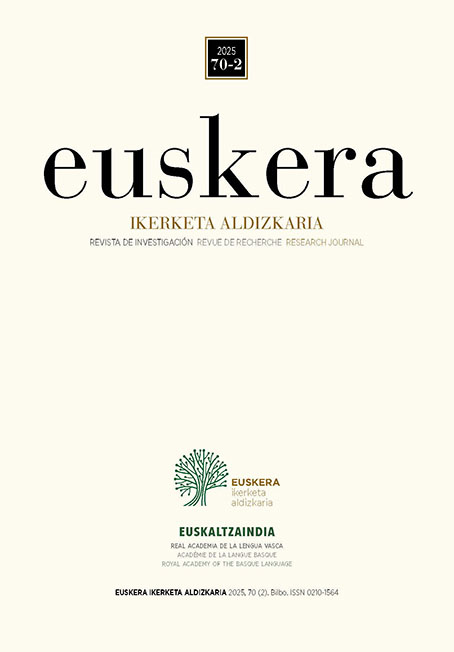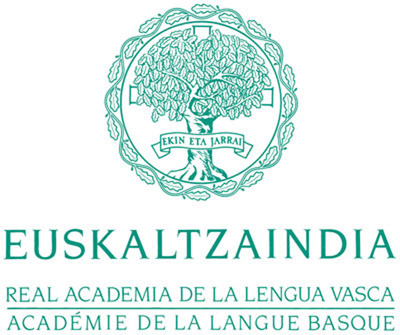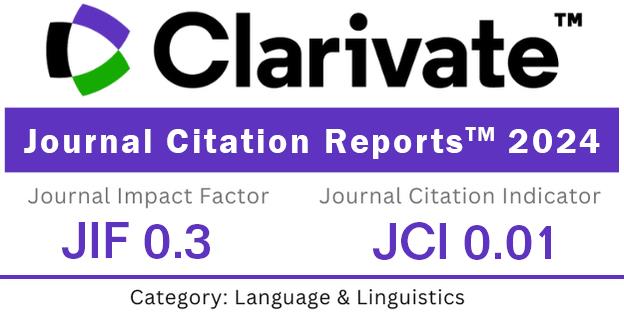Rhythm of Basque varieties
DOI:
https://doi.org/10.59866/eia.v2025i70.318Keywords:
Basque varieties, rhythm, stress, syllable, moraAbstract
In this research, we analyze rhythm across Basque varieties, a topic that remains largely understudied. While the scarce studies available to date classify the Basque language as syllable-timed, some studies argue that it might approach other rhythmic classes, such as mora-timed. It has also been discussed if there are differences among Basque varieties. In fact, the different Basque varieties exhibit phonological alternations such as deletions, syncopes or apheresis. As all of these partially affect their syllabic structure, they could lead to cross-dialectal differences in their rhythm. The goal of this paper is thus to systematically analyze the varieties of Bermeo, Bilbo, Donostia and Baztan. Our results show that the different varieties do not differ in their percentages of vocalic intervals (V %), but do differ significantly in the standard deviation of their consonant intervals (ΔC), specifically between the varieties spoken in Baztan and Donostia. Furthermore, they suggest that, in certain aspects, these Basque dialects are closer to other languages classified as mora-timed than to the languages traditionally classified as syllable-timed.
Downloads
References
Bertinetto, Pier Marco (1988). «Reflections on the dichotomy “stress-” vs. “syllable-timed”», First International Conference on Experimental Phonostylistics and Sociophonology and Speech Acoustic Variability (Florianópolis, Brasil).
Boersma, Paul eta Weenink, David (2023). Praat. Amsterdam: Phonetic Sciences, University of Amsterdam.
Camino, Iñaki (2009). Dialektologiatik euskalkietara tradizioan gaindi. Donostia: Elkar.
Dellwo, Volker (2006). «Rhythm and speech rate: A variation coefficient for ∆C» in P. Karnowski eta I. Szigeti (arg.), Language and language-processing. Frankfurt/Main: Peter Lang: 231-241.
Gandarias, Maria Rosario (1991). On the Rhythmical Type of Basque. EHU/UPV. (Argitalpen digitala). Kontsultagai: [https://www.isca-archive.org/ppst_1991/gandariasolaeta91_ppst.pdf].
Grabe, Esther eta Ling Low, Ee (2002). «Durational variability in speech and the rhythm class hypothesis», in C. Gussenhoven eta N. Warner (arg.), Papers in Laboratory Phonology 7. Berlin: Mouton de Gruyter: 515-546. DOI: https://doi.org/10.1515/9783110197105.2.515
Hurch, Bernhard (1988). «Is Basque a syllable-timed language?», Anuario del Seminario de Filología Vasca Julio de Urquijo 22 (3): 813-825. DOI: https://doi.org/10.1387/asju.8013
Ibarra, Orreaga (2019). «Muga eta trantsizioa Nafarroako euskal hizkeretan», RLLCGV 24: 227-251. DOI: https://doi.org/10.5944/rllcgv.vol.24.2019.26413
Ladefoged, Peter (1975). A Course in Phonetics. New York: Harcourt Brace Jovanovich.
Loukina, Anastassia, Ochanski, Greg, Rosner, Burton, Keane, Elinor eta Shih, Chilin (2011). «Rhythm measures and dimensions of durational variation in speech», Journal of the Acoustical Society of America 129: 3258-3270. DOI: https://doi.org/10.1121/1.3559709
Molnar, Monika, Gervain, Judit eta Carreiras, Manuel (2014). «Within-rhythm class native language discrimination abilities of Basque-Spanish monolingual and bilingual infants at 3.5 months of age», Infancy 19 (3): 326-337. DOI: https://doi.org/10.1111/infa.12041
Nazzi, Thierry, Bertoncini, Josiane eta Mehler, Jacques (1998). «Language discrimination by newborns: Toward an understanding of the role of rhythm», Journal of Experimental Psychology: Human Perception and Performance 24: 756-766. DOI: https://doi.org/10.1037//0096-1523.24.3.756
Nespor, Marina, Shukla, Mohinish eta Mehler, Jacques (2004). Grammar on a Language Map. Trieste: International School for Advanced Studies (SISSA).
Nespor, Marina, Shukla, Mohinish eta Mehler, Jacques (2011). «Stress-timed vs. syllable-
timed languages», in M. Oostendorp, C.J. Ewen, E. Hume eta K. Rice (arg.), The Blackwell Companion to Phonology. Malden, MA: Wiley-Blackwell: 1147-1157.
Oñederra, Miren Lourdes (2004). Fonetika fonologia hitzez hitz. Bilbo: Euskal Herriko Unibertsitatea (EHU/UPV).
Pike, Kenneth L. (1945). The Intonation of American English. Ann Arbor: University of Michigan Press.
Ramus, Franck eta Mehler, Jacques (1999). «Language identification with suprasegmental cues: A study based on speech resynthesis», Journal of the Acoustical Society of America 105: 512-521. DOI: https://doi.org/10.1121/1.424522
Ramus, Franck, Nespor, Marina eta Mehler, Jacques (1999). «Correlates of linguistic rhythm in the speech signal», Cognition 73: 265-292. DOI: https://doi.org/10.1016/S0010-0277(99)00058-X
Salaburu, Patxi eta Lakar, Maite (2005). Baztango mintzoa: gramatika eta hiztegia. Iruñea: Nafarroako Gobernua eta Euskaltzaindia.
Vicenik, Caroline eta Sundara, Megha (2013). «The role of intonation in language and dialect discrimination by adults», Journal of Phonetics 41 (5): 297-306. DOI: https://doi.org/10.1016/j.wocn.2013.03.003
Zuazo, Koldo (2014). Euskalkiak. Donostia: Elkar.
Downloads
Additional Files
Published
Issue
Section
License
Copyright (c) 2025 Maddi Ormazabal Sudupe, Ane Berro, Irene Delacruz-Pavía

This work is licensed under a Creative Commons Attribution-NonCommercial 4.0 International License.








